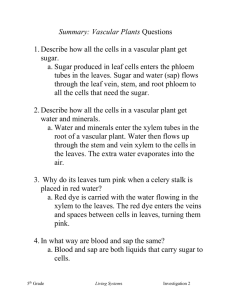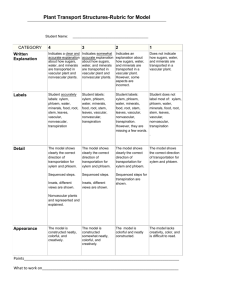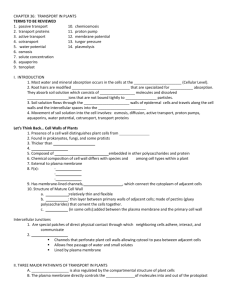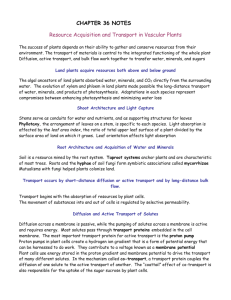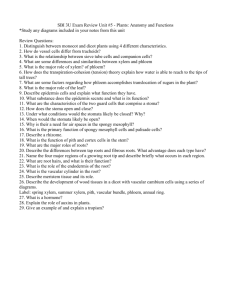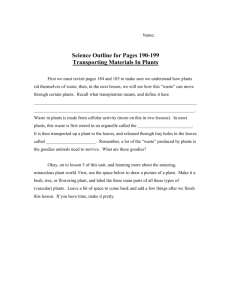Transport in Vascular Plants
advertisement
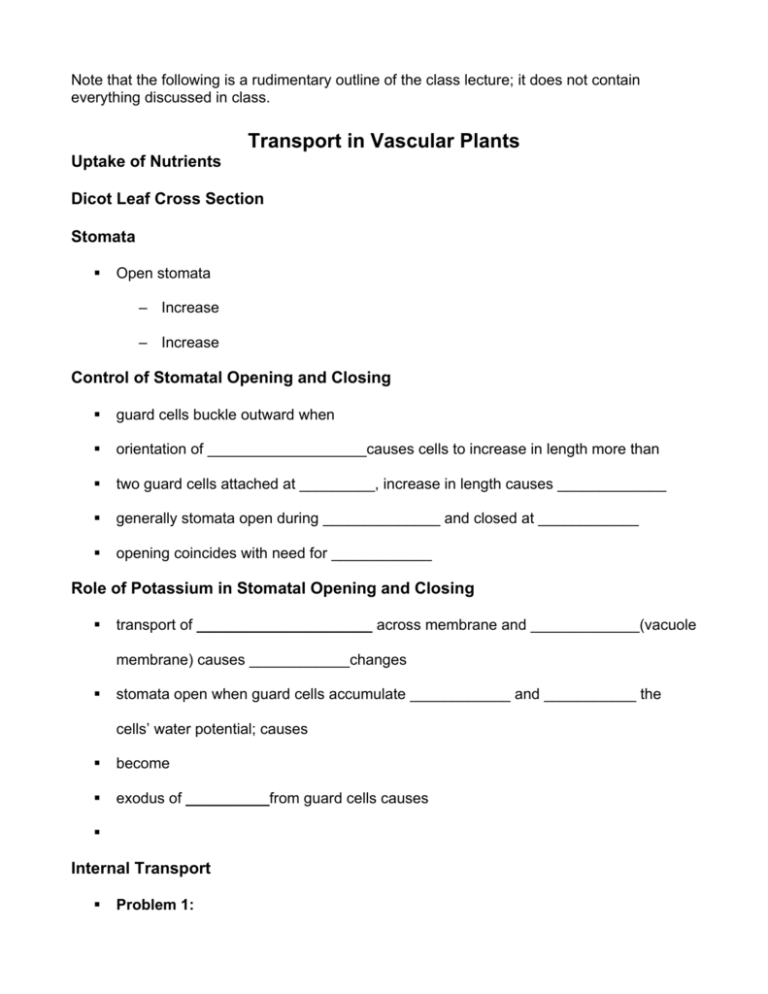
Note that the following is a rudimentary outline of the class lecture; it does not contain everything discussed in class. Transport in Vascular Plants Uptake of Nutrients Dicot Leaf Cross Section Stomata Open stomata – Increase – Increase Control of Stomatal Opening and Closing guard cells buckle outward when orientation of ___________________causes cells to increase in length more than two guard cells attached at _________, increase in length causes _____________ generally stomata open during ______________ and closed at ____________ opening coincides with need for ____________ Role of Potassium in Stomatal Opening and Closing transport of _____________________ across membrane and _____________(vacuole membrane) causes ____________changes stomata open when guard cells accumulate ____________ and ___________ the cells’ water potential; causes become exodus of __________from guard cells causes Internal Transport Problem 1: Lecture 5 – Transport in Vascular Plants Problem 2: Lateral Transport of Water & Minerals in Roots ________________ pathway – movement through cell walls, between plant cells, not across cell membranes – an extracellular pathway ________________ pathway – H20 moves from cell to cell via – areas where the ______________ of cells _______________ together – slower process than via ______________ pathway Endodermis – 1 layer of cells (6 sided) surrounding stele – in/on walls of 4 sides – suberin prevents H20 etc. from passing through ____________ of adjacent cells – forces H20 and dissolved minerals to follow ____________________ – ________________ allows plant to select what substances pass into stele and up into plant Lateral Transport of Water and Minerals in Roots Transport of Xylem Sap Xylem sap – water, mineral ions (______________), trace amounts of other molecules BIOL 1030 2 Lecture 5 – Transport in Vascular Plants How does xylem sap rise against gravity, without help of any mechanical pump, to reach heights of more than 100 m in the tallest trees? Several steps (mechanisms) needed to achieve this 1. 2. 3. Water Potential A measurement of the combination of solute ______________ and _______________ Greek letter Distilled water in an open beaker has a water potential of will be dealing with water moves across a membrane from a solution with ________ Ψ to a solution with __________ Ψ units called ____________________ (abbreviated MPa ) Active Transport Water moves easily into _____________ of endodermal cells Mineral uptake into __________ (through membrane) of endodermal cells is __________ and ___________ Harmful minerals are _____________ excluded by membrane Endodermal cell membrane proteins _____________ minerals against their concentration gradient using _________ Once in symplast of endodermal cells minerals move easily into stele and then into xylem through _________________ connecting cells Root Pressure BIOL 1030 3 Lecture 5 – Transport in Vascular Plants ______________________ and subsequent accumulation of minerals in xylem results in a solution (xylem sap) with _________ Ψ lower Ψ causes ___________ of water Water and minerals that have entered xylem are _____________ and cannot leave the stele because of _______________________________ Continued increase of minerals and ___________ in xylem causes a build up of ___________ __________pressure forces “___________" water and minerals up root and stem inside xylem This process explains Terminology – Water loss - water moves from interior to exterior of leaf caused by evaporation – attraction between water molecules – water molecules stick to one another – forming – attraction between water molecules and other _____________ molecules – water molecules adhere to sides of – capillary action – Surface tension Cohesion-Tension Model BIOL 1030 4 Lecture 5 – Transport in Vascular Plants – _______________ of water to atmosphere is replaced by water from ____________, which is replaced by water from the continuous ________ stream – As water molecules leave ________, they drag other water molecules along with them – Due to ___________ of water molecules to one another, a continuous _________ of interacting water molecules is formed in the __________ from the roots to the leaves – _______________ to xylem vessel walls fights ______________ – _______________ forces pull water upward through __________, all the way from roots Ascent of Water Guttation the morning after a windless night “________” droplets maybe seen on tips of grass blades or leaf margins of some small, not to be confused with roots of some plants keep accumulating ________________ during night root pressure pushes ________________ into shoot system because _______________ rate is low, more water enters leaves than is __________ excess is forced out as Summary Only ________ of water used by plant used in photosynthesis and plant growth Most of it is lost in _____________________ BIOL 1030 5 Lecture 5 – Transport in Vascular Plants – provides the ___________ for lifting water up stems – ________________ leaves Transpiration rate is regulated by – – – – Single corn plant can transpire ________________of water in growing season Stomata ________ when water uptake is ______ than _________________ rate Water loss is a result of ______________, since stomata must be open for _________ Transport of Phloem Sap – sucrose up to __________; amino acids; minerals; ___________ – transport of food in plant – organ in which sugar is produced by either – ______________ leaves are ______________ sugar sources – organ that is net ______________ or ______________ of sugar – e.g. BIOL 1030 6 Lecture 5 – Transport in Vascular Plants – may be ___________ or ____________ depending on season – Sugar _________ during summer when storage organ is _________ carbohydrates – Sugar __________ in early spring after breaking dormancy, when its starch is _______________ to sugar and ______________ to growing tips Hypothesis Direction that phloem sap travels is predicts that __________________________of sugars is from – __________________________________ to – ____________________________ ________ sink usually receives its sugar from __________ is loaded into phloem near sites of _________, or ________, using ___________ supplied by __________ cells or other nearby _______________ cells Movement of water containing dissolved __________ and other __________ in phloem requires ___________ Pressure Flow in a Sieve Tube _______________ of sugar into sieve tube at source reduces ___________ in sieve tube members _________ from surrounding tissues moves into sieve elements due to low _______ potential Absorption of _______ generates a __________ pressure that forces sap to flow along tube The pressure gradient in tube is reinforced by _________________ of sugar and consequent loss of _____________ from tube at sink BIOL 1030 7 Lecture 5 – Transport in Vascular Plants In the case of leaf to root ______________, xylem recycles ____________ from sink to source Transport in phloem can be _________________, although individual sieve elements can only transport in ______________ at any one time Pressure Flow Hypothesis Experiments have shown that this is mechanism of translocation in angiosperms To test hypothesis researchers used ____________ that feed on phloem sap – ___________probes with a __________ that penetrates a sieve-tube member – _____________-like mouthpart As sieve-tube pressure force-feeds ________, they can be severed from their – which serve as taps exuding sap for hours Researchers measured the flow and sugar concentration of sap from _________ at different points between a source and sink RESULTS the closer the ____________ was to a sugar source – the ___________ the sap flowed – the ____________ its sugar concentration CONCLUSION The results of such experiments support the pressure flow hypothesis Uptake of Nutrients Lateral Transport of Minerals and Water in Roots Plant Mineral Requirements Macronutrients - some BIOL 1030 8 Lecture 5 – Transport in Vascular Plants – component of nucleic acids, amino acids, chlorophyll, etc. – component of nucleic acids, ATP, phospholipids (membranes) – Cofactor for many enzymes – e.g. – involved in cell wall structure & cytoplasmic control functions – component of two amino acids – e.g. Micronutrients - some – involved in synthesis of chlorophyll – component of chlorophyll Plant Nutrition & Mycorrhizae – modified roots consisting of mutualistic associations of fungi and roots – benefits from a steady supply of sugar donated by host plant In return – increases ______________ of water uptake and mineral absorption – supplies _____________________ to host plant BIOL 1030 9 Lecture 5 – Transport in Vascular Plants Farmers & foresters – often ____________ seeds with ______________ of mycorrhizal fungi to promote formation of mycorrhizae Types of Mycorrhizae E mycelium of fungus forms a _____________________ over surface of root fungal hyphae extend from _________ into soil, absorbing water and minerals, especially ________________. hyphae also extend into _______________ spaces of root cortex – providing extensive surface area for nutrient exchange between fungus and host plant. E No ___________ forms around root, but microscopic fungal hyphae __________ into root Within root cortex, the fungus makes extensive contact with plant through branching of ___________ that form ______________ – providing an enormous surface area for nutrient swapping __________ penetrate cell walls, but not __________________, of cells within cortex Plant Nutritional Adaptations some plants use other organisms in _________________ ways unusual nutritional adaptations in plants Epiphytes – cup - rosette of overlapping leaves BIOL 1030 10 Lecture 5 – Transport in Vascular Plants some ferns produce "__________________" that collect litter – ____________ roots go into soil in basket – eg. Parasitic Plants photosynthetic nonphotosynthetic Carnivorous Plants derive some or most of their nutrients from trapping – – especially usually grow in places where soil poor in – especially found – in – on Carnivorous Plants BIOL 1030 11
